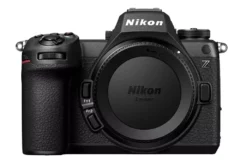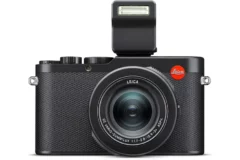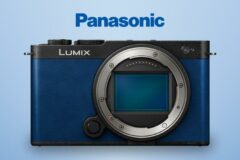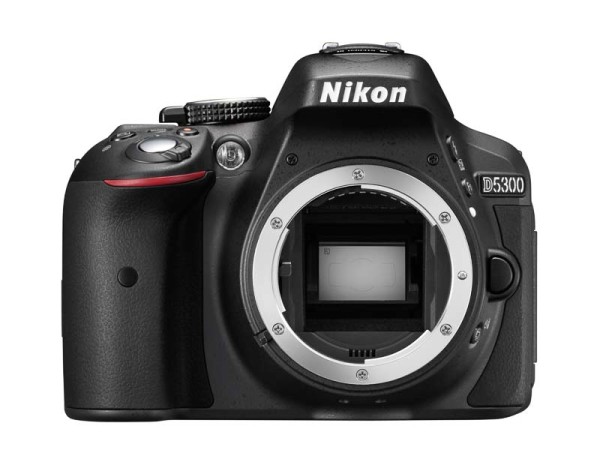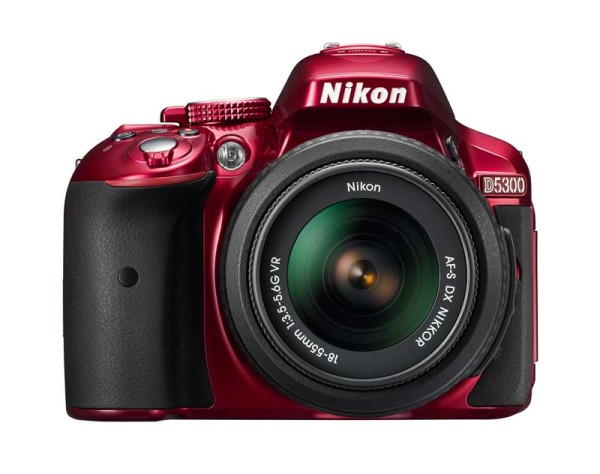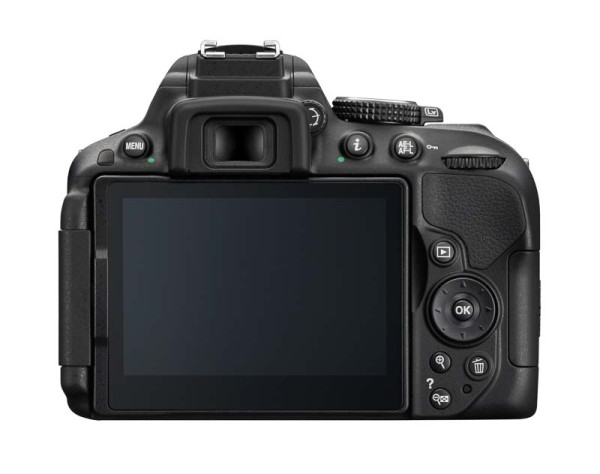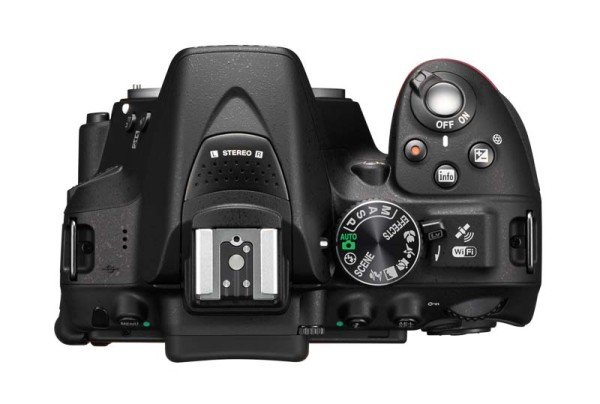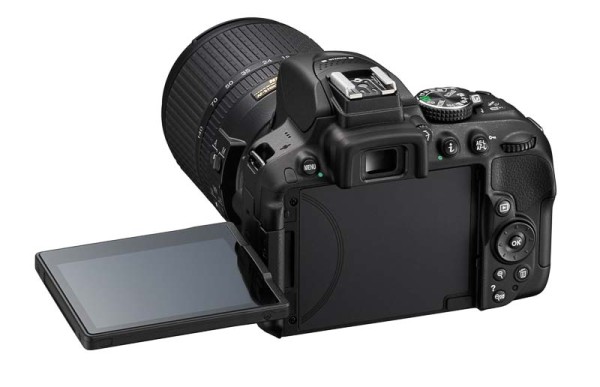Nikon D5300 DSLR Camera Announced, Price, Specs, Features
Nikon has officially announced the new mid-range Nikon D5300 digital SLR camera. Nikon D5300 DSLR camera specs, features and price information with product images can be seen below.
Nikon’s new DX-format D5300 DSLR camera features built-in Wi-Fi and GPS, a 24.2-megapixel DX-format CMOS sensor with no optical low-pass filter and EXPEED 4 image processing engine.
Nikon D5300 also features a 3.2 inch vari-angle screen, ISO 10-25,600, 39-point AF system with nine cross-type sensors, and Full HD movies at 1080/50/60p.
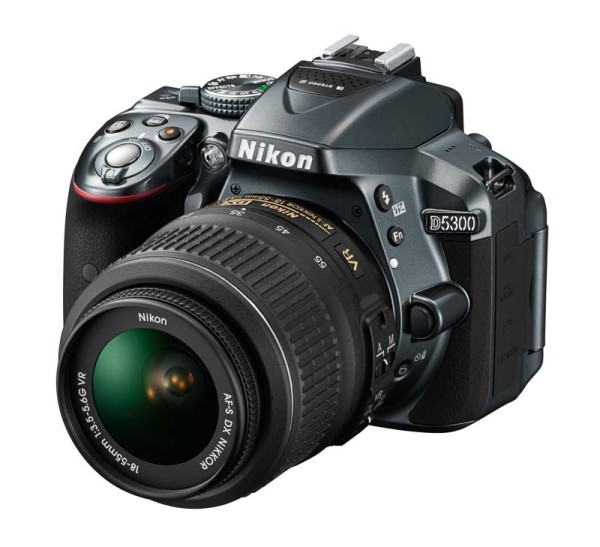
Nikon D5300 DSLR Camera Price
Nikon D5300 DSLR camera body only price is $796.95. The Nikon D5300 kit with the AF-S DX NIKKOR 18-140mm f/3.5-5.6G ED VR lens price is $1,399.95. Nikon D5300 will start shipping on November 14 in Black, Red and Gray colors.
| Pre-order & Buy Nikon D5300 DSLR Camera | ||
|---|---|---|
| Nikon D5300 Body Only | $796.95 | Amazon | Adorama | ebay |
| Nikon D5300 kit with the AF-S DX NIKKOR 18-140mm f/3.5-5.6G ED VR lens | $1,399.95 | Amazon | Adorama |
Nikon D5300 DSLR Camera Features
Advanced Performance for When it Matters Most
Making memorable moments even better, the Nikon D5300 offers stunning image quality with sharp, crisp detail to preserve life’s precious memories. The enhanced 24.2-megapixel CMOS sensor delivers stunning images and HD videos with heightened clarity and detail due to the removal of the optical low pass filter (OLPF). From planned family portraits to candid moments, the D5300 has the performance, along with easy and intuitive features, to help users capture photos confidently, including:
- Amazing Low Light Performance – For clean, sharp details even in the most challenging lighting conditions including night games and dimly lit restaurants, the Nikon D5300 covers a wide ISO range of 100-12,800 and is expandable to ISO 25,600.
- EXPEED 4 Image Processing – Nikon’s most recent image processing engine drives the rapid response and swift performance of the D5300, while maximizing energy efficiency, reducing image noise and delivering true-to-life colors.
- Scene Recognition System – To further help users capture the image they intend, the Nikon D5300 features Nikon’s Scene Recognition System and 2,016-pixel RGB metering system to analyze and recognize the scene. Utilizing these systems results in adjustments to exposure, AF and white balance to deliver the best photo possible, whether it’s a landscape or portrait.
- 39-Point AF System – Nikon’s quick and precise 39-point AF system works with the Scene Recognition System to accurately acquire and track subjects throughout the frame, resulting in tack-sharp images. Kids too active to pose for a photo or pets chasing after a toy are easily captured in brilliant sharpness for memorable photos.
- 5 Frames-Per-Second – While using the optical viewfinder or in Live View, capture great moments that would have otherwise been missed with the D5300’s 5 frames-per-second (fps) rate.
Share Like Never Before
The Nikon D5300 is Nikon’s first D-SLR to feature built-in Wi-Fi, allowing the user to share high quality photos instantly. The Nikon D5300 sends images to the user’s smart device, allowing them to share their D-SLR quality photos through e-mail and social media. From a winning touchdown to a surprise proposal, friends and family can now see these important moments clearly captured right after they happen. The Nikon D5300 also includes built-in GPS, another first for Nikon D-SLRs. Now the user can geotag images and allow others to see where life has taken them.
Features for Creativity and Versatility
Compact and lightweight (16.9 oz.), the Nikon D5300 can easily be packed for a day trip or a planned getaway. The small body of the D5300 affords the photographer the freedom to travel while still being easy to handle and comfortable to use. In addition to being able to capture amazing images anywhere, the Nikon D5300 is also packed with additional features to promote creativity and versatility, including:
- 3.2-inch Vari-Angle LCD monitor – Whether shooting above a crowd or getting low to capture the details of a flower, users can explore new shots from a dramatic point of view with the large 3.2-inch Vari-angle LCD monitor. This super sharp (1,037K-dot) screen allows photographers to easily make camera adjustments and read menus, while also allowing them to compose the photo they want clearly when shooting from high or low angles. The rotating LCD makes it easy to capture “selfies” at an arm’s length away or frame creative perspectives when capturing still photos and HD video.
- Full HD 1080p Video Capture – Create movies fit for the big screen with Full HD 1080p video capture at 60p with built-in stereo, wide ISO range for high quality videos in any light and improved full-time AF to keep the subject in focus.
- NIKKOR Compatibility – The Nikon D5300 is compatible with Nikon’s legendary NIKKOR lenses and powerful system accessories, further adding versatility and creativity.
Nikon D5300 DSLR Camera Specifications
| Type | Single-lens reflex digital camera |
| Lens mount | Nikon F mount (with AF contacts) |
| Effective angle of view | Nikon DX format; focal length equivalent to approx. 1.5x that of lenses with FX format angle of view |
| Effective pixels | 24.2 million |
| Image sensor | 23.5 x 15.6 mm CMOS sensor |
| Total pixels | 24.78 million |
| Dust-reduction System | Image sensor cleaning, Image Dust Off reference data (optional Capture NX 2 software required) |
| Image size (pixels) | 6000 x 4000 (Large) 4496 x 3000 (Medium) 2992 x 2000 (Small) |
| File format | NEF (RAW): 12- or 14 bit, compressed JPEG: JPEG-Baseline compliant with fine (approx. 1 : 4), normal (approx. 1 : 8), or basic (approx. 1 : 16) compression NEF (RAW)+JPEG: Single photograph recorded in both NEF (RAW) and JPEG formats |
| Picture Control System | Standard, Neutral, Vivid, Monochrome, Portrait, Landscape; selected Picture Control can be modified; storage for custom Picture Controls |
| Media | SD (Secure Digital) and UHS-I compliant SDHC and SDXC memory cards |
| File system | DCF (Design Rule for Camera File System) 2.0, DPOF (Digital Print Order Format), Exif (Exchangeable Image File Format for Digital Still Cameras) 2.3, PictBridge |
| Viewfinder | Eye-level pentamirror single-lens reflex viewfinder |
| Frame coverage | Approx. 95% horizontal and 95% vertical |
| Magnification | Approx. 0.82 x (50 mm f/1.4 lens at infinity, -1.0 m-1) |
| Eyepoint | 18 mm (-1.0 m-1; from center surface of viewfinder eyepiece lens) |
| Diopter adjustment | -1.7 – +1.0 m-1 |
| Focusing screen | Type B BriteView Clear Matte Mark VII screen |
| Reflex mirror | Quick return |
| Lens aperture | Instant return, electronically controlled |
| Compatible lenses | Autofocus is available with AF-S and AF-I lenses. Autofocus is not available with other type G and D lenses, AF lenses (IX NIKKOR and lenses for the F3AF are not supported), and AI-P lenses. Non-CPU lenses can be used in mode M, but the camera exposure meter will not function. The electronic rangefinder can be used with lenses that have a maximum aperture of f/5.6 or faster. |
| Type | Electronically-controlled vertical-travel focal-plane shutter |
| Speed | 1/4000 – 30 s in steps of 1/3 or 1/2 EV; Bulb; Time |
| Flash sync speed | X=1/200 s; synchronizes with shutter at 1/200 s or slower |
| Release mode | Single frame, continuous L, continuous H, quiet shutter release, self-timer, delayed remote; ML-L3, quick-response remote; ML-L3; interval timer photography supported |
| Frame advance rate | Continuous L : Up to 3 fps Continuous H : Up to 5 fps (JPEG and 12-bit NEF/RAW) or 4 fps (14-bit NEF/RAW) Note: Frame rates assume continuous-servo AF, manual or shutterpriority auto exposure, a shutter speed of 1/250 s or faster, Release selected for Custom Setting a1 (AF-C priority selection), and other settings at default values. |
| Self-timer | 2 s, 5 s, 10 s, 20 s; 1-9 exposures |
| Metering mode | TTL exposure metering using 2016-pixel RGB sensor |
| Metering method | Matrix metering: 3D color matrix metering II (type G, E, and D lenses); color matrix metering II (other CPU lenses) Center-weighted metering: Weight of 75% given to 8-mm circle in center of frame Spot metering: Meters 3.5-mm circle (about 2.5% of frame) centered on selected focus point |
| Range (ISO 100, f/1.4 lens, 20 °C/68 °F) | Matrix or center-weighted metering: 0-20 EV Spot metering: 2-20 EV |
| Exposure meter coupling | CPU |
| Mode | Auto modes (auto; auto (flash off)); programmed auto with flexible program (P); shutter-priority auto (S); aperture-priority auto (A); manual (M); scene modes (portrait; landscape; child; sports; close up; night portrait; night landscape; party/indoor; beach/snow; sunset; dusk/dawn; pet portrait; candlelight; blossom; autumn colors; food); special effects modes (night vision; color sketch; toy camera effect; miniature effect; selective color; silhouette; high key; low key; HDR painting) |
| Exposure compensation | Can be adjusted by -5 – +5 EV in increments of 1/3 or 1/2 EV in P, S, A, and M modes |
| Bracketing | Exposure bracketing: 3 shots in steps of 1/3 or 1/2 EV White balance bracketing: 3 shots in steps of 1 Active D-Lighting bracketing: 2 shots |
| Exposure lock | Luminosity locked at detected value with AE-L/AF-L button |
| ISO sensitivity (Recommended Exposure Index) | ISO 100-12800 in steps of 1/3 EV. Can also be set to approx. 0.3, 0.7, or 1 EV (ISO 25600 equivalent) above ISO 12800; auto ISO sensitivity control available |
| Active D-Lighting | Auto, Extra high, High, Normal, Low, Off |
| Autofocus | Nikon Multi-CAM 4800DX autofocus sensor module with TTL phase detection, 39 focus points (including 9 cross-type sensor), and AF-assist illuminator (range approx. 0.5-3 m/1 ft 8 in.-9 ft 10 in.) |
| Detection range | -1 – +19 EV (ISO 100, 20 °C/68 °F) |
| Lens servo | Autofocus (AF): Single-servo AF (AF-S); continuous-servo AF (AF-C); auto AF-S/AF-C selection (AF-A); predictive focus tracking activated automatically according to subject status Manual focus (MF): Electronic rangefinder can be used |
| Focus point | Can be selected from 39 or 11 focus points |
| AF-area mode | Single-point AF, 9-, 21-, or 39- point dynamic-area AF, 3D-tracking, auto-area AF |
| Focus lock | Focus can be locked by pressing shutter-release button halfway (single-servo AF) or by pressing AE-L/AF-L button |
| Built-in flash | Auto, portrait, child, close up, night portrait, party/indoor, pet portrait, color sketch, toy camera effect: Auto flash with auto pop-up P, S, A, M, food: Manual pop-up with button release |
| Guide Number | Approx. 12/39, 13/43 with manual flash (m/ft, ISO 100, 20 °C/68 °F) |
| Flash control | TTL: i-TTL flash control using 2016-pixel RGB sensor is available with built-in flash and SB-910, SB-900, SB-800, SB-700, SB-600, SB-400, or SB-300; i-TTL balanced fill-flash for digital SLR is used with matrix and center-weighted metering, standard i-TTL flash for digital SLR with spot metering |
| Flash mode | Auto, auto with red-eye reduction, auto slow sync, auto slow sync with red-eye reduction, fill-flash, red-eye reduction, slow sync, slow sync with red-eye reduction, rear-curtain with slow sync, rear-curtain sync, off |
| Flash compensation | -3 – +1 EV in increments of 1/3 or 1/2 EV |
| Flash-ready indicator | Lights when built-in flash or optional flash unit is fully charged; flashes after flash is fired at full output |
| Accessory shoe | ISO 518 hot-shoe with sync and data contacts and safety lock |
| Nikon Creative Lighting System (CLS) | Advanced Wireless Lighting supported with SB-910, SB-900, SB-800, or SB-700 as a master flash or SU-800 as commander; Flash Color Information Communication supported with all CLS-compatible flash units |
| Sync terminal | AS-15 sync terminal adapter (available separately) |
| White balance | Auto, incandescent, fluorescent (7 types), direct sunlight, flash, cloudy, shade, preset manual, all except preset manual with fine-tuning. |
| Lens servo | Autofocus (AF): Single-servo AF (AF-S); full-time-servo AF (AF-F) Manual focus (MF) |
| AF-area mode | Face-priority AF, wide-area AF, normal-area AF, subject-tracking AF |
| Autofocus | Contrast-detect AF anywhere in frame (camera selects focus point automatically when face-priority AF or subject-tracking AF is selected) |
| Automatic scene selection | Available in auto and auto (flash off) modes |
| Metering | TTL exposure metering using main image sensor |
| Metering method | Matrix |
| Frame size (pixels) and frame rate | 1920 x 1080, 60p (progressive)/50p/30p/25p/24p, high/normal 1280 x 720, 60p/50p, high/normal 640 x 424, 30p/25p, high/normal Frame rates of 30p (actual frame rate 29.97 fps) and 60p (actual frame rate 59.94 fps) are available when NTSC is selected for video mode. 25p and 50p are available when PAL is selected for video mode. Actual frame rate when 24p is selected is 23.976 fps. |
| File format | MOV |
| Video compression | H.264/MPEG-4 Advanced Video Coding |
| Audio recording format | Linear PCM |
| Audio recording device | Built-in or external stereo microphone; sensitivity adjustable |
| ISO sensitivity | ISO 100-12800; can also be set to approx. 0.3, 0.7, or 1 EV (ISO 25600 equivalent) above ISO 12800 |
| Monitor | 8.1 cm/3.2-in. (3 : 2), approx. 1037k-dot (720 x 480 x 3 = 1,036,800 dots), vari-angle TFT monitor with 170 ° viewing angle, approx. 100% frame coverage, and brightness adjustment |
| Playback | Full-frame and thumbnail (4, 12, or 80 images or calendar) playback with playback zoom, movie playback, photo and/or movie slide shows, histogram display, highlights, auto image rotation, picture rating, and image comment (up to 36 characters) |
| USB | Hi-Speed USB |
| Video output | NTSC, PAL |
| HDMI output | Type C mini-pin HDMI connector |
| Accessory terminal | Wireless remote controllers: WR-1, WR-R10 (available separately) Remote cords: MC-DC2 (available separately) GPS units: GP-1/GP-1A (available separately) |
| Audio input | Stereo mini-pin jack (3.5mm diameter); supports optional ME-1 stereo microphones |
| Standards | IEEE 802.11b, IEEE 802.11g |
| Communications protocols | IEEE 802.11b: DSSS/CCK IEEE 802.11g: OFDM |
| Operating frequency | 2412-2462 MHz (channels 1-11) |
| Range (line of sight) | Approximately 30 m/98 ft (assumes no interference; range may vary with signal strength and presence or absence of obstacles) |
| Data rate | 54 Mbps Maximum logical data rates according to IEEE standard. Actual rates may differ. |
| Security | Authentication: Open system, WPA2-PSK Encryption: AES |
| Wireless setup | Supports WPS |
| Access protocols | Infrastructure |
| Receiving frequency | 1575.42 MHz (C/A code) |
| Geodesics | WGS84 |
| Supported languages | Arabic, Bengali, Chinese (Simplified and Traditional), Czech, Danish, Dutch, English, Finnish, French, German, Greek, Hindi, Hungarian, Indonesian, Italian, Japanese, Korean, Norwegian, Persian, Polish, Portuguese (Portugal and Brazil), Romanian, Russian, Spanish, Swedish, Tamil, Thai, Turkish, Ukrainian, Vietnamese |
| Battery | One rechargeable Li-ion EN-EL14a battery |
| AC adapter | EH-5b AC adapter; requires EP-5A power connector (available separately) |
| Tripod socket | 1/4 in. (ISO 1222) |
| Dimensions (W x H x D) | Approx. 125 x 98 x 76 mm (49.2 x 3.9 x 3 in.) |
| Weight | Approx. 530 g (1 lb 2.7 oz) with battery and memory card but without body cap; approx. 480 g/1 lb 0.9 oz (camera body only) |
| Temperature | 0 °C – 40 °C (+32 °F – 104 °F) |
| Humidity | 85% or less (no condensation) |
| Supplied accessories | BS-1 accessory shoe cover, DK-25 rubber eyecup, BF-1B body cap, EN-EL14a rechargeable Li-ion battery (with terminal cover), MH-24 battery charger, AN-DC3 strap, UC-E17 USB cable, EG-CP16 audio/video cable, DK-5 eyepiece cap, ViewNX 2 CD, Reference CD (contains the Reference Manual) |
Nikon D5300 DSLR Camera Product Images
